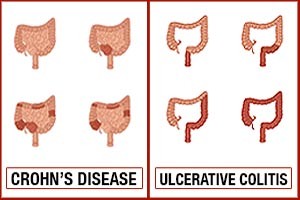Crohn’s disease vs. ulcerative colitis, differences in symptoms, causes, and treatment
 Crohn’s disease and ulcerative colitis are part of the group of conditions known as inflammatory bowel diseases (IBD). Prior to the 20th century, before the rise of hygiene and urbanization, inflammatory bowel disease was quite rare. Currently, IBD is found in developed countries and is believed to be caused by a lack of germ resistance development – although the exact cause is still unknown.
Crohn’s disease and ulcerative colitis are part of the group of conditions known as inflammatory bowel diseases (IBD). Prior to the 20th century, before the rise of hygiene and urbanization, inflammatory bowel disease was quite rare. Currently, IBD is found in developed countries and is believed to be caused by a lack of germ resistance development – although the exact cause is still unknown.
For those living with IBDs, their immune system mistakes food and bacteria in the gastrointestinal tract for an allergen or foreign substance, so it sends out cells to destroy it. The result of these attacks is chronic inflammation.
Although the exact causes of Crohn’s disease and ulcerative colitis are unknown, genetics and environmental factors are believed to play a role. Crohn’s disease and ulcerative colitis are often interchanged for one another, but we will outline the differences between the two, including symptoms, causes, and treatments in order to provide you with a better understanding of either condition.
Connection between Crohn’s disease and ulcerative colitis
At first, Crohn’s disease and ulcerative colitis will appear the same as they do share many symptoms. This can make diagnosis right off the bat quite difficult until further investigation and testing is underway. Shared symptoms seen across many IBDs include diarrhea, rectal bleeding, urgent need to release bowels, abdominal cramps and pain, sensation of incomplete emptying, constipation, fever, loss of appetite, weight loss, fatigue, night sweats, and loss of menstrual cycle. Recognizing any of these early symptoms can prompt you to speak to your doctor about a possible IBD.
The biggest connection between Crohn’s disease and ulcerative colitis is that they both involve an abnormal response by the body’s immune system. The immune system’s role is to protect the body, but in inflammatory bowel disease this response in abnormal, thus attacking whatever enters the gastrointestinal tract whether it is good or bad. Over time, if treatment is not administered long-term damage can occur to the digestive system and the risk of serious complications arises.
Crohn’s disease and ulcerative colitis: Table
The following table highlights the similarities and differences between Crohn’s disease and ulcerative colitis.
findings Rectum frequently spared
Inflammation not continuous (presence of skip lesions)
Bowel wall is thickened and has a ‘cobblestoned’ appearance due to deep ulcers and swelling of the tissue Rectum always affected
Inflammation is uniformBowel wall is thin with loss of vascular pattern
(blood vessels not visible) Radiology Strictures are common
Deep fissures and fistulae are common
Asymmetrical inflammation Strictures and fissures are much less common
Symmetrical inflammation Histology Presence of granulomas are almost diagnostic
Inflammation extends through the mucosa and
muscle of the bowel
The increase in white cells that tend to be lymphocytes Granulomas absent
Inflammation usually confined to mucosa
The increase in white cells that tend to be polymorphs Diet Remission achieved with enteral feed followed by
exclusion/ elimination diet Unaffected by diet Clinical
appearance Patients often thin and may be malnourished due to
intestinal malabsorption of nutrients
Diarrhea – only sometimes with blood
Abdominal mass common Weight loss usually related to the severity of active disease
Bloody diarrhea
Abdominal mass uncommon Smoking Strongly associated with smoking
Predicts a worse course of disease
Increases risk of surgery Associated with non-smokers or ex-smokers
Appears to protect against disease
Crohn’s disease vs. ulcerative colitis: U.S. prevalence and incidence rate
The CDC estimated that one to 1.3 million Americans is affected by IBD. Generally, ulcerative colitis is found to be more common in males where Crohn’s disease is more common in females. Prevalence of Crohn’s disease in the U.S. is 26 to 199 per 100,000 persons, and ulcerative colitis is 37 to 246 per 100,000 persons.
Incidence rate of Crohn’s disease is 3.1 to 14.6 cases per 100,000 person years, and for ulcerative colitis it is 2.2 to 14.3 cases per 100,000 person years.
Distinguishing between Crohn’s disease and ulcerative colitis signs and symptoms
 In either disease, symptoms can range from mild to severe and can even occur as flare-ups if not well managed. Although primary symptoms of Crohn’s disease and ulcerative colitis affect the gastrointestinal tract, other symptoms may also occur, affecting other parts of the body.
In either disease, symptoms can range from mild to severe and can even occur as flare-ups if not well managed. Although primary symptoms of Crohn’s disease and ulcerative colitis affect the gastrointestinal tract, other symptoms may also occur, affecting other parts of the body.
Crohn’s disease symptoms include diarrhea, fever and fatigue, abdominal pain and cramping, blood in stool, mouth sores, reduced appetite and weight loss, drainage near the anus due to fistula, inflammation of the skin, eyes, and joints, inflammation of the liver and bile ducts, and delayed growth or sexual developing in children.
Ulcerative colitis symptoms include abdominal pain, increased abdominal sounds, blood stools, diarrhea, fever, rectal pain, weight loss, malnutrition, joint pain and swelling, mouth sores, nausea, vomiting, and skin ulcers.
Difference between Crohn’s disease and ulcerative colitis causes
As with many autoimmune diseases, the exact cause of either Crohn’s disease or ulcerative colitis is unknown. Some theorized causes of Crohn’s disease include the immune system being triggered by a virus or bacteria, and heredity as many patients with Crohn’s disease will also have a relative with the condition.
The immune system is also suspected to play a role in ulcerative colitis along with genetics and environmental factors. There seems to be some genes involved in the development of ulcerative colitis, and having more than four family members with ulcerative colitis increases your risk of developing it. Environmental factors include place of residence, especially because there appear to be higher rates of ulcerative colitis in urban areas, North America, and Western Europe. Air pollution, medications, and consuming certain diets have also been found to be associated with a higher risk of ulcerative colitis.
Crohn’s disease and ulcerative colitis differences in risk factors and complications
 Risk factors for Crohn’s disease include being aged under 30, being white or of Jewish descent, having family history of Crohn’s disease, smoking cigarettes, using nonsteroidal anti-inflammatory medications, and living in an urbanized area where you eat a high-fat diet or plenty of refined foods.
Risk factors for Crohn’s disease include being aged under 30, being white or of Jewish descent, having family history of Crohn’s disease, smoking cigarettes, using nonsteroidal anti-inflammatory medications, and living in an urbanized area where you eat a high-fat diet or plenty of refined foods.
Ulcerative colitis risk factors are having a family history of colitis, being Caucasian, and taking certain medications such as Accutane, Amnesteem, Claravis, or Sotret.
If not well managed, both Crohn’s disease and ulcerative colitis can progress into complications. Complications associated with Crohn’s disease include inflammation, which can cause the bowel to narrow, bowel obstructions, ulcers, fistulas, anal fissures, malnutrition, colon cancer, osteoporosis, gallbladder, liver disease, and anemia.
Complications that can arise in ulcerative colitis are colon cancer, thickening of the intestinal wall, blood infections, severe dehydration, rapidly swelling colon, liver disease, intestinal bleeding, kidney stones, hole in the colon, ankylosing spondylitis (inflammation of joints between the spinal bones), and inflammation of skin, joints, and eyes.
Crohn’s disease vs. ulcerative colitis: Diagnosis and treatment
Crohn’s disease is diagnosed through a detailed examination of one’s medical and family history, as well as additional testing as needed.
Because Crohn’s disease can mimic other conditions like infections, diverticulitis, and cancer, it’s important to rule them out. Blood tests are ineffective in diagnosing Crohn’s disease, so an ultrasound, CT scan, MRI, colonoscopy, and internal biopsy may be conducted.
Crohn’s disease has a long list of treatment methods because it does not have an exact cause to target. Treatment for Crohn’s disease may include corticosteroids, anti-inflammatory drugs, immunosuppressant agents, antibiotics, biologic agents, nutritional and dietary counseling, stress management, and, in severe Crohn’s disease cases, surgery to remove heavily affected areas of the intestines and colon.
Since some ulcerative colitis symptoms are similar to Crohn’s disease, it is important to get a thorough examination and diagnosis. Ulcerative colitis diagnosis is conducted through a number of tests. Essentially, it is a process of eliminating other conditions. If your doctor suspects an inflammatory bowel issue, they may conduct one or more of the following:
- Stool tests
- Endoscopy – a flexible tube is used to examine the small intestine
- Colonoscopy – a flexible tube inserted into the rectum to examine the colon
- Biopsy – an examination of tissue removed from the colon, likely during colonoscopy
- Barium enema – X-rays taken of colon and rectum, using barium to provide contrast.
- Blood tests – to check for low blood count and C-reactive proteins.
If a diagnosis of ulcerative colitis is confirmed, the doctor will discuss the best possible treatment options. Ulcerative colitis treatment can involve drug therapy, surgery, or in cases where the condition is mild, it can simply mean lifestyle changes.
In some instances, medications are prescribed to help reduce inflammation. Reducing the inflammation can minimize both abdominal cramps and diarrhea. Serious inflammatory bowel disease may require antibiotics or other medications to alter immune function.
When symptoms of ulcerative colitis are severe, hospitalization may be necessary. Oftentimes, severe cases lead to dehydration and malnutrition. Severe symptoms could be a sign of a perforated colon or even cancer. Surgery may be required. There are two surgical options. One, called aprotocolectomy, involves removal of the entire colon and rectum. The other involves removal of part of the colon. This is called ileonal anastomosis. When aprotocolectomy is performed, a surgeon makes a small opening in the abdominal wall to bring the tip of the lower small intestine through the skin’s surface. Waste is then drained through the opening into a bag. With the ileonal anastomosis, feces can still pass through the rectum since the rectum is intact, but the movements will be frequent and watery.
If ulcerative colitis goes undiagnosed and untreated, inflammation can spread, causing problems with other organs and potentially leading to cancer, so proper care and treatment are vital.
Celiac disease vs. Crohn’s disease, differences in symptoms, causes, and treatments
Celiac disease and Crohn’s disease both cause inflammation of the intestines, and although there are some overlapping symptoms, each condition has its own unique disease course that requires a very specific form of treatment. Continue reading…
-
Are There Any Alternatives Of Lena Muscle X?
Are you dreaming of a great body with many curves, which you wanted fr
-
The Most Successful Weight Loss Infomercials
Only in America could billions of dollars be made selling weight loss
-
Breaking Through your Weight Loss and Body Transformation Plateaus
The biggest challenge when starting any
-
How To Lose One Pound A Year BFJ Diet Followup
In my original article on the Big Fat John Plan for losing weight I to
-
Definite Diet Donts - Learn How To Not Sabotage Your Diet Goals
You have done so well for on your diet a
-
Can I Take Weight Loss Pills During Pregnancy?
Can I Take Weight Loss Pills During Pregnancy? Most definitely not!
- DON'T MISS
- 19 Reasons People Fail To Achieve Their Fitness Goals
- Five Secrets To Weight Loss
- The Best Kept Secret Of Fast Weight Loss
- Lose Weight In A Week Fast And Its Health Issues
- Weight Loss Surgery Tips That You Should Know About
- Lose The Pounds And Not The Fun – Easy Weight Loss Advice
- Lose Weight Without Even Trying
- Weight Loss Surgery - Preventing Health Risks
- Simple Steps to Lose 10 Pounds Safely & Quickly
- Very Overweight? Dont Go to the Gym!




